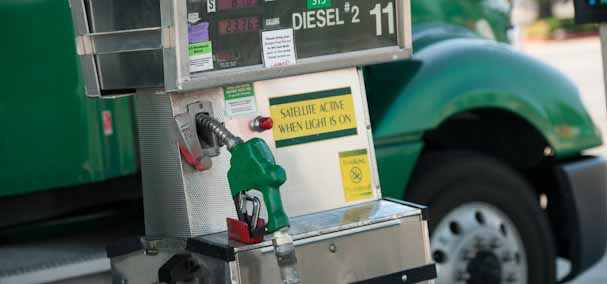Diesel prices have fallen below $2.15 per gallon at the pump, as a national average. If your truck gets six miles to the gallon, your fuel cost is only 35¢ per mile. How could that possibly be bad?
Lower fuel prices lead to a lower fuel surcharge. Every shipper has a different formula to calculate the fuel surcharge, but typically you gain 1¢ of surcharge for every 5¢ or 6¢ increase in the price of diesel. Freight brokers typically quote one-time rates that combine the surcharge with the line haul into a total for the whole trip.
Carriers benefit because costs are down, but also because 30-day terms mean you're getting paid now for a haul in December, when the surcharge was closer to 19¢. Meanwhile, fuel prices dropped again, so next week's surcharge will be closer to 14¢. If your company improves its mileage, or finds another way to cut costs, those few extra pennies per mile go straight to your bottom line.
 Of course, revenue drops, too.
Of course, revenue drops, too. Owner-operators are sensitive to this, but it hurts the big guys, too. For-hire truck tonnage increased 2.2% in 2015, but public trucking companies were pummeled by the stock market. With the savings on fuel, you'd expect them to do well, but the largest fleets spent that money on a record number of trucks in 2015 and an increase in driver pay. Now those big fleets have lots of capacity, and they can service their shipper customers better, but the earnings don't look so great.
Weak players stay in business longer when fuel costs are low. Ordinarily, low rates would starve small and poorly managed carriers, but they survive somehow, filling their tanks at $2.11 or less per gallon. That means there's even more capacity, and more competition, which drives rates still lower.
Also Read:
Driving For Fuel Efficency Webinar
There's a silver lining. Or maybe it's a plastic lining. Due to low oil prices, the U.S. is able to manufacture some products, including chemicals and plastic resins that are derived from petroleum, and export them at favorable prices. Demand has been strong within the U.S. for autos and auto parts, which also contribute to freight volume.
Unfortunately, other cargo types, including oil drilling equipment and fracking sand, are not in high demand compared to previous years. New construction is not exactly booming, either, the steel industry is suffering. Worse, consumers did not spend their gas savings on Christmas presents, which was a big disappointment to economists as well as retailers.
Rates are low now, but a rebound may be just a few months away. There are good reasons to
expect spot market rates to rise in the second half of the year, or possibly as soon as the second quarter. Right now, carriers can take advantage of low fuel prices during the slow season, to get acquainted with new customers, new markets and new cargo types that require freight transportation. When freight picks up again in the spring, you'll be ready.
Freightliner’s Team Run Smart is partnering with DAT to offer a special on the TruckersEdge load board to its members. Sign up for
TruckersEdge today and get your first 30 days free by signing up at www.truckersedge.net/promo717 or entering “promo717” during sign up.
* This offer is available to new TruckersEdge subscribers only
About TruckersEdge®, powered by DAT®
TruckersEdge® Load Board is part of the trusted DAT® Load Board Network. DAT offers more than 68 million live loads and trucks per year. Tens of thousands of loads per day are found first or exclusively on the DAT Network through TruckersEdge.
This article was originally featured on
DAT.com.